Content
- 1 Greenhouse requirements
- 2 Selection of vegetables
- 3 Seedling preparation
- 4 Soil and fertilizers
- 5 Care features
- 6 Seat selection
- 7 Choice of materials
- 8 Assembling a greenhouse from cellular polycarbonate
- 9 Features of a brick greenhouse
- 10 Heating system
- 11 What vegetables are grown in the greenhouse all year round
- 12 Construction of a greenhouse for growing vegetables
- 13 Basic recommendations for the agricultural technology of vegetable crops in the greenhouse
- 14 Transplanting
- 15 We take care of the seedlings correctly
Greenhouse requirements
How to equip a greenhouse for growing vegetables in winter? When designing a year-round greenhouse, it is important to meet all the conditions for successful plant growth: ensuring the required temperature and humidity, the amount of sunlight, the possibility of airing. At the same time, it is necessary to calculate the costs of heating and lighting the greenhouse so that they do not block the benefits of winter vegetables.
Year-round greenhouse must have a solid foundation... To provide the required height for the plants, the structure can be slightly deepened. This little trick will help you save on heating costs and not lose the natural light you need.
It is best to grow vegetables in a medium-sized greenhouse, up to 20 m long and 2.5-3 m wide... The optimal roof structure is pitched. The north wall can be laid out with cinder blocks or wooden beams, protecting the plants from the winter wind. The greenhouse should have a vestibule and double doors. Comfortable air vents.
Most often, capital greenhouses are made on a welded frame with an anti-corrosion coating. Such a foundation will stand for many years, the greenhouse will be strong and reliable. As a coating, you can use dense polyethylene or tempered industrial glass. But the most expensive and high quality material - cellular polycarbonate. It transmits light well and retains heat even in the most severe frosts.
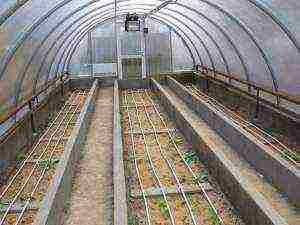 For heating, pipes on both sides of the greenhouse are suitable. The heat source will be an electric boiler. It is possible to heat the structure with modern wood-burning stoves that save fuel.
For heating, pipes on both sides of the greenhouse are suitable. The heat source will be an electric boiler. It is possible to heat the structure with modern wood-burning stoves that save fuel.
Increasing the temperature inside the greenhouse will help and biofuel - rotted manuremixed with straw. The mixture is laid out under the top layer of soil. Biofuel is suitable for growing cucumbers, radishes and other crops that are particularly heat-demanding.
Selection of vegetables
In a winter greenhouse can grow all kinds of crops, from popular tomatoes to cabbage lettuce and herbs. Among the most popular and fruitful vegetables:
- cucumbers;
- tomatoes;
- radish;
- head salad;
- eggplant;
- Bell pepper;
- various varieties of cabbage;
- zucchini.
It should be borne in mind that crops have different requirements for humidity and temperature, so they need to be placed in separate greenhouses. For example, tomatoes and bell peppers require moderate moisture (no more than 60%) and frequent ventilation. Such a regime is destructive for cucumbers, which need a humid and hot atmosphere.
In the cold season, the greenhouse effect with high humidity is easier to maintain.
Therefore, many novice gardeners focus on popular and productive crops that need just this mode: cucumbers and radishes.
Choosing varieties, it is worth giving preference to hybridscultivated specifically for indoor use.These plants have a shortened growing season and do not require insect pollination. Most greenhouse varieties have good yields and pest resistance.
Seedling preparation
Some gardeners buy grown seedlings at markets and other farms. But grow your own seedlings from seed much more profitable... In addition, the process can be started at any time to ensure a year-round harvest.
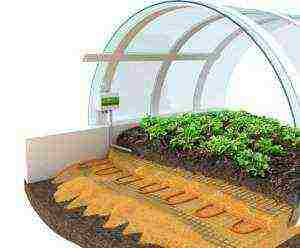 It is better to grow seedlings in a separate greenhouse or in a house. Seed germination conditions are different from those to which adult plants exist. In some cases, a lower temperature or higher humidity is required. In the same greenhouse, you can place seedlings of different crops with similar requirements for agricultural technology.
It is better to grow seedlings in a separate greenhouse or in a house. Seed germination conditions are different from those to which adult plants exist. In some cases, a lower temperature or higher humidity is required. In the same greenhouse, you can place seedlings of different crops with similar requirements for agricultural technology.
If there is no opportunity to organize a greenhouse for seedlings, the seeds can be germinated on a separate rack in a common room located as close to the lamps as possible. The seeds can be germinated in peat cups, but this method is not suitable for eggplants and other crops with a weak root system. For year-round cultivation, the conveyor method is recommended.
Seeds are sown every 2 weeks, which makes it possible to get seedlings of different ages. If different crops are planted, after a year it is recommended to alternate them... Eggplant seedlings are planted in the places that were occupied by tomatoes, and cucumbers are replaced with radishes or zucchini.
This technique does not allow the soil to deplete. The first sowing can be started in January. Depending on the growing season of a particular plant, the seedlings will ready for transplant in 3-5 weeks after sowing seeds.
Soil and fertilizers
How to grow vegetables in a greenhouse all year round? Vegetables need light, not too acidic soils. For most crops, a mixture of garden soil, sand and peat is suitable.
Before laying in the greenhouse the soil needs to be calcined or disinfected using an aqueous solution of copper sulfate. Such treatment kills harmful microorganisms and insect larvae.
After processing, ash or a complex of mineral fertilizers can be added to the soil. The mixture is thoroughly loosened and distributed over the ridges. In the greenhouse, you can organize both ground and rack cultivation. The racks are suitable for radishes, head lettuce and other small crops. Some vegetable growers successfully grow tomatoes and zucchini on shelves.
Indoor ground is quickly depleted, so the plants in the greenhouse need to be constantly fertilized. Rotted compost or complex mineral fertilizers are added to the soil. This treatment is repeated every 2 weeks, before feeding the soil must be loosened and weeds removed. During the period of active growth of seedlings, special attention should be paid to nitrogen fertilization, from time to time the plants can nourish with medicinal preparations.
Care features
In winter, you need to maintain an average daily temperature of 18 to 22 degrees. Overheating has a bad effect on tomatoes, eggplants and bell peppers, and a cold snap can have a detrimental effect on radishes and cucumbers. On frosty days, greenhouses are not ventilated, when the outside temperature rises, the vents need to be opened 1-2 times a day.
Vegetables in the greenhouse watered 2-3 times a weekwhen the soil dries up a little. It is advisable to use water at the same temperature as the air in the greenhouse. Cold water can cause shock and slow plant development.
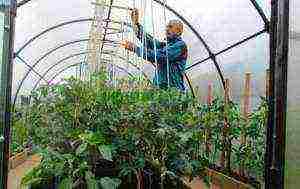 As the plant grows, it is necessary to tie up the stems. Cucumbers need special supports to be mounted on the roof of the greenhouse. With their help, the stems of plants can be directed in the right direction, which is especially convenient for rack cultivation.
As the plant grows, it is necessary to tie up the stems. Cucumbers need special supports to be mounted on the roof of the greenhouse. With their help, the stems of plants can be directed in the right direction, which is especially convenient for rack cultivation.
With the onset of fruit formation it is recommended to remove the lower leaves on the stems. Excessive green mass interferes with fruit development. In addition, this technique will improve air exchange and access to sunlight, plants will not be affected by pests and fungi.
In the greenhouse it is important to maintain the atmospherefavorable for plants. The humidity level will help increase watering of heating pipes and floor with water, as well as placing open tanks in the room. For the successful ripening of tomatoes in the greenhouse, you can put tanks with an aqueous solution of mullein. Good increase moisture and hot water barrels, moreover, they additionally heat the room.
With conveyor cultivation, harvesting takes place all year round. In early summer and late autumn, preventive treatment of premises with partial replacement of soil and thorough washing of all surfaces is recommended. After airing and fertilizing, a new stage of planting begins.
Success growing vegetables in a greenhouse in winter, depends on the region... The most profitable option is to use greenhouses in temperate and climates. Regions with short summers and long frosty in winter will require high heating costs.
In such an area, it is more advisable to extend the summer period until the end of October and practice early planting in heated soil. Using correctly selected varieties of vegetable crops, you can achieve a good harvest.
Simple innovations in the design of greenhouses for growing vegetables all year round, in the video below:
With the development of technological progress, people began to think about how important it is to take care of their health, to eat tasty and healthy vegetables all year round. Inevitably, many questions arise: how to achieve high crop yields in any season, what vegetables to plant, how to care for them in order to provide yourself with vitamins all year round? With a competent approach to work, everything will definitely work out.
Most suitable types
The technology of growing vegetables implies a competent combination of various crops. Different plants require different levels of moisture, soil composition, temperature. Therefore, if you have only one greenhouse, you will have to choose one or three crops.
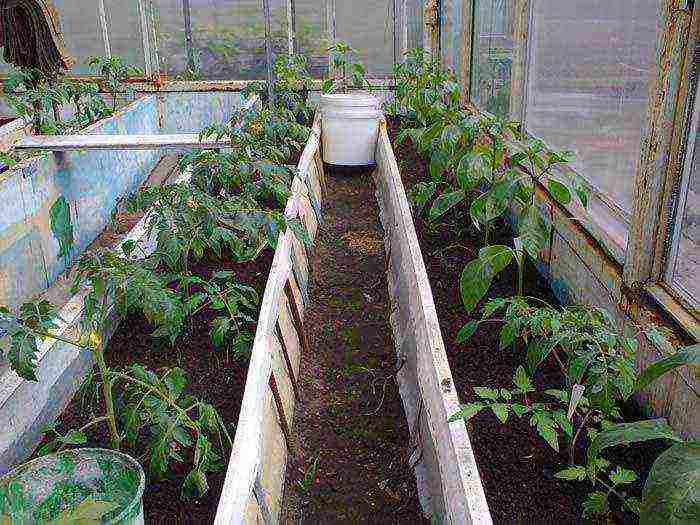
It is most profitable to grow the following types of vegetables in a greenhouse:
- Sweet peppers and tomatoes. These vegetables require great care, but in terms of their taste and yield, they outperform other species. However, the use of different stimulants and hydroponics is required.
- Cucumbers. This type of vegetables in greenhouses grows quite quickly: from the beginning of sowing to fruiting, it takes about 2 months. Cucumbers are stored well, but they require careful maintenance and take up a lot of space.
- All year round in an apartment and a greenhouse made of polycarbonate, you can grow such fast-growing vegetables as radish and Chinese cabbage. These types do not require careful maintenance. Radish is not susceptible to diseases, it is well stored. Several harvests can be obtained per year. If the vegetables are grown properly, a continuous flow of produce can be achieved.
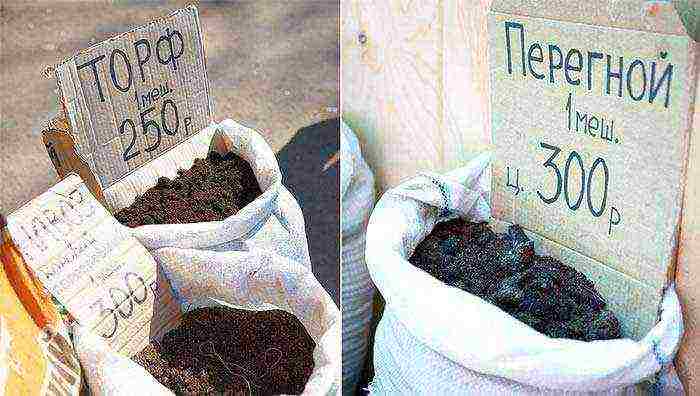
We recommend that you familiarize yourself with:
General rules of planting and care
In a polycarbonate greenhouse, plants need careful maintenance. You will have to perform many large and small works, but the result is worth it: with proper cultivation, the harvest will be rich.
When cultivating vegetables in winter and spring in an apartment or polycarbonate building, the following organizational conditions should be observed:
- choose a reliable material for floors;
- think over the design of the greenhouse;
- install an automatic control system;
- constantly look after the soil.
You should also adhere to the general recommendations for growing crops in greenhouses:
- Planting vegetables involves airing buildings.
- Some plants should be shaded.
- Vegetables must be fertilized with top dressing during the entire growing period.
- Adequate watering should be carried out - for each crop its own.
- An optimal microclimate should be created in the greenhouse.
- Heating of a building in central Russia is required all year round.
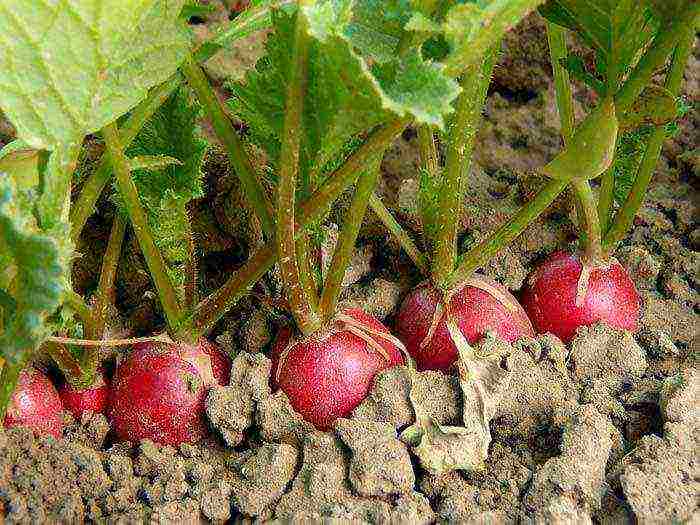
Cultivation of plants in a greenhouse involves monitoring the following parameters:
- ventilation - a draft must not be allowed, an air speed sensor must be installed;
- humidity;
- the temperature level in the building is important even at the beginning of planting;
- soil temperature;
- the volume of water supply - the best option is constant drip irrigation;
- the level of concentration of organic matter and microelements in the soil;
- the temperature of the water for irrigation should be equal to the temperature of the soil.
Sunny Vegetarian (video)
Vegetable compatibility rules
In spring and winter, many types of vegetables can be placed in the greenhouse, given their compatibility:
- radishes, lettuce, small onions and tomatoes grow well together;
- peppers and herbs can be planted with any crops;
- peppers and eggplants get along well - vegetables are thermophilic and prefer the same watering regime;
- tomatoes in the spring feel great with pepper - these are nightshade crops, which means that they have the same care system;
- do not combine tomatoes and cucumbers;
- the neighborhood of cabbage and parsley, sorrel, spinach is not recommended;
- you cannot plant tomatoes and eggplants together, despite the fact that they require a similar microclimate.
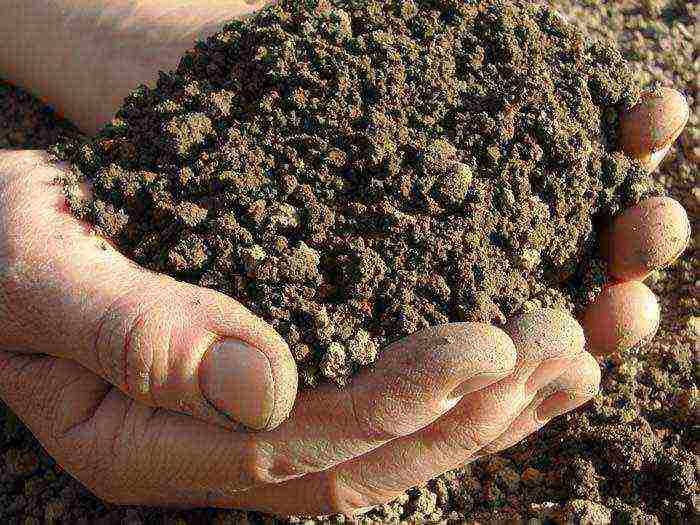
We also suggest that you read the article in which we talk about the compatibility of cucumbers and peppers in a greenhouse.
Features of crop rotation
To achieve a good harvest, you should observe the crop rotation of vegetables. For example, tomatoes should not be cultivated after peppers, cucumbers, potatoes and eggplants. The best precursors for tomatoes are beans and onions.
Cucumbers, if you plant plants all year long, should not be grown after zucchini, melon and watermelon. The best option is planting after radishes or onions.
How to grow a good crop of beans? It should not be planted after the beans. Onions grow well after flowers, carrots, cucumbers and cabbage. It is better to plant cabbage after garlic, onions, beets or carrots.
Crop rotation is relevant all year round when growing vegetables both in an apartment and in a polycarbonate building. Plant compatibility is determined by the similarity of the optimal conditions for their growth. Some require increased watering, others - a temperature of at least 20 degrees.
If you don't want crop compatibility issues in spring or winter, it's best to use one greenhouse for one type of vegetable. The change of culture should be accompanied by a change of soil and processing of the structure of the building.
How to grow a good harvest? Observe the crop rotation! For a year in a polycarbonate building, you can get 3 types of different vegetables. Changing species in winter or spring helps to protect the soil from the accumulation of harmful substances. However, after planting each type of vegetables, decontamination will have to be carried out.
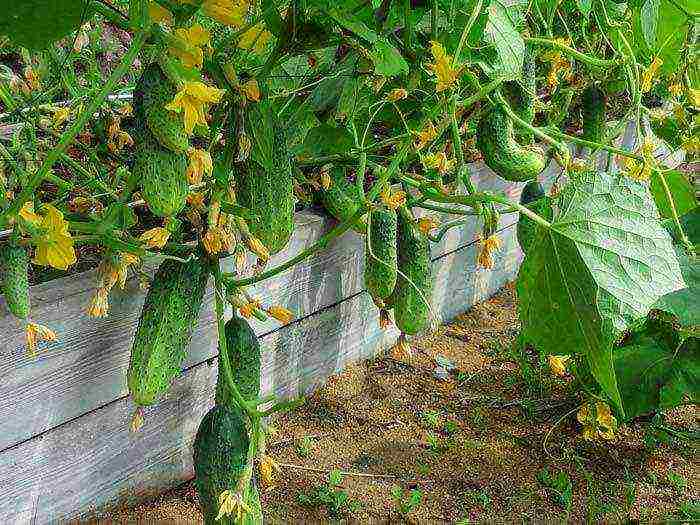
You may also be interested in the article in which we talk about how to disinfect the soil in a greenhouse and what it is for.
Tips & Tricks
In order to successfully grow vegetables all year long, you need to have an understanding of the classification of plants. It's pretty simple.
The top level is a division into:
- crops with a short growing season (additional);
- the main types of plants.
Knowledge that will be needed at the stage of growing seedlings:
- pumpkin plants - watermelon, zucchini, melon, pumpkin;
- haze - spinach, beets;
- umbrella - carrots, parsley, celery;
- cruciferous - radishes, cabbage, rutabagas;
- Compositae - chicory and lettuce;
- nightshades - peppers, eggplants and tomatoes.
How to grow seedlings of the presented vegetables? It is grown mainly in spring.
Another principle of dividing cultures is by fruit:
- root vegetables - carrots, potatoes, onions;
- fruit - tomatoes, peppers, cucumbers;
- leafy - asparagus, spices, cabbage.
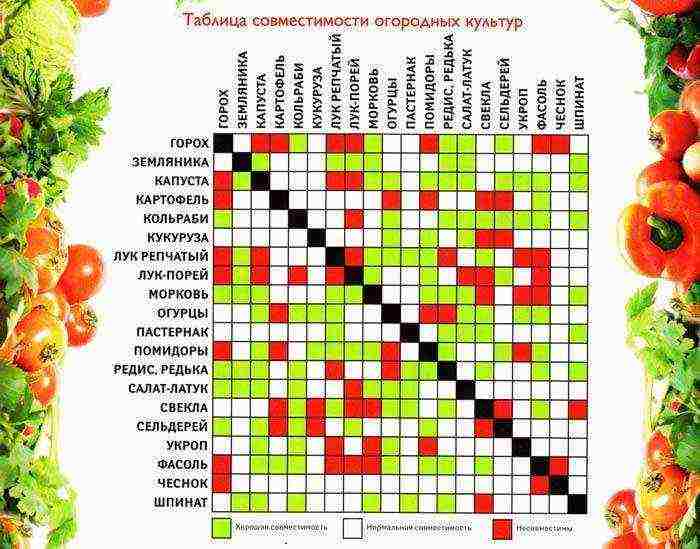
This classification determines how plants should follow each other for a whole year in a polycarbonate structure. It is recommended to first plant leafy plants, then root crops and fruit, and so on in a circle.
According to the level of nutrient intake in winter and spring, vegetables are divided into the following groups:
- with low consumption - beans and beans;
- with medium consumption - kohlrabi, radish and asparagus;
- with strong consumption - leeks, tomatoes, celery.
Soil question
Vegetables that are grown in an apartment or greenhouse for a whole year are very demanding on the soil. It should concentrate useful trace elements, substances and organic matter.
The soil is prepared in the fall. It should include:
- manure;
- carbohydrate fertilizers;
- peat;
- turf;
- hay or straw;
- nitrogen-containing fertilizers.
Greenhouse for the whole year (video)
You can cultivate vegetables in a polycarbonate building for a whole year. This is a very exciting and rewarding activity. However, in order to get a good harvest in an apartment or greenhouse, you will have to try and follow a number of rules. Your efforts will be rewarded with multiple ripening of delicious and healthy vegetables.
In order not to lose the material, be sure to save it to your social network
Attention, only TODAY!
Reviews and comments
Many summer residents would like to grow fresh vegetables all year round. It is possible to come to the country house even in winter. The building is heated, with all communications. For vegetables, if you want to start growing them in winter and spring, you will also need a warm house. A year-round greenhouse with heating can be equipped with your own hands.
How to build a greenhouse for growing vegetables all year round
Seat selection
The most important thing to start is to choose the right place. The location will determine the efficiency of the greenhouse by 30%.
Choosing a place for a greenhouse
Table. Options for choosing a location for a greenhouse
| Daylight | Of course, in a stationary year-round greenhouse, additional artificial lighting will have to be provided, but why not 100% use the capabilities of nature. Plants should be provided with as much daylight as possible. By placing the greenhouse structure from west to east in an open area, you will get maximum sun for the plants. |
| Wind | Cold winds are able not only to penetrate into the structure through any even small cracks, but also, acting from the outside, to reduce the temperature in it by 2-5 degrees. For young seedlings, this change can be disastrous. Therefore, when installing the greenhouse, take care of its additional protection from the wind. |
| Water | Ideally, an automatic irrigation system is present in a year-round greenhouse. But if one is not available, the hydraulic communications should be located close, for convenient and prompt water intake and irrigation. Water temperature, especially in winter, also matters. Watering seedlings with cold water is unacceptable. |
| Approaches | Few people pay attention to this parameter. However, the approach to the greenhouse should be wide and comfortable. This will not only facilitate its construction, but also make it comfortable and efficient to use. |
Greenhouse location
Choice of materials
What to build from? There are many options. You need to choose such a material so that the structure will last a long time, be durable, airtight, economical. In this regard, the old classic film and glass structures, equipped with frame structures using wood, are finally a thing of the past.
Why are film, glass and wood not suitable?
Greenhouse made of wood and glass - photo
- Even heavy duty film can tear - heat leakage will occur.
- In the frames and between them, gaps will necessarily form over time, through which heat will also go away.
- Glass breaks and has low heat transfer in one layer.
What materials to choose for a year-round greenhouse?
- The frame structure can be used for the installation of metal-plastic frames, provided they are double-glazed.
- Greenhouse walls can be made of metal-based polycarbonate.
- For a year-round greenhouse, a brick building is suitable.
Reliability, long service life, protection for growing crops - these are the main parameters for choosing a greenhouse building material.
Assembling a greenhouse from cellular polycarbonate
Consider the polycarbonate structure, the features of its assembly and the tools and additional materials necessary for this.
What is good about polycarbonate
This modern material has many positive performance qualities.
- It has excellent thermal insulation properties.
- It has a surprisingly flexible structure - it bends easily without breaking, which makes it possible to install even arched structures.
- This new material is 16 times lighter than the thinnest glass.
In polycarbonate structures, shaped pipes act as a frame. In addition to them, you will need:
- welding machine;
- polycarbonate sheets;
- bolts and sealant.
The assembly can be carried out in a few hours, according to the instructions that are attached to the finished greenhouse.
Advice! Not all ready-made structures provide transoms, but it is better to provide them, the possibility of airing will protect the plants from overheating.
The frame is assembled with bolts. Sheets are inserted into the frame. Remember to tilt the roof (35 degrees is sufficient) to keep snow from accumulating. Places of planks with open honeycombs on polycarbonate are treated with a sealant to minimize heat loss.
Features of a metal-plastic greenhouse
Do-it-yourself metal-plastic structures are not the easiest thing. The most durable it will turn out from specialists, therefore it is better to make a greenhouse frame to order in a construction company that specializes in the manufacture of such products. Plus, the frame will need double glazing, which is also better to entrust to specialists.
As a result, the full cost of such a year-round greenhouse will not come cheap. But this is the most real opportunity to grow greens and vegetables all year round.
Advice! When installing a metal-plastic glazed greenhouse, it is recommended to make one (northern) wall not of glass and insulate it.
The roof of such a greenhouse tilts 30 degrees. It is preferable to choose a single slope configuration.
Features of a brick greenhouse
A brick greenhouse, or as it is also called capital, is a real "home" for plants, where life is possible all year round. This is not even a greenhouse already, but a real greenhouse, in which you can grow not only vegetables, but also various exotic plants. Until now, despite new modern materials, such as metal-plastic and cellular polycarbonate, the option of a capital brick greenhouse is considered the most reliable, proven, optimal, effective.
How to build a brick greenhouse
The construction can be done by hand if you have at least minimal skills in brickwork and other construction work. But even without labor costs, a greenhouse will require a substantial financial investment.
You will need:
- brick;
- mineral wool;
- cement, sand;
- roofing material;
- boards, timber for rafters;
- windows, doors, gutters.
The peculiarities of the construction are that, unlike all other types of greenhouses, the brick one is a "two-room apartment" for green pets. The first room is the vestibule. Usually it occupies an area of 2x2 m or 2x2.5 m. Garden accessories, fertilizers, soil and other necessary things are stored in the vestibule, and a heating system (boiler, stove) is also installed.
The main greenhouse space can be any area that you are able to develop.
The partition between the two rooms is made capital. A door is installed in it. The second door from the vestibule leads outside. In the greenhouse, not only windows are made, but also transoms.
Another feature - for a capital greenhouse, you will have to fill in the foundation, preferably a strip one.
Table. The main stages of the construction of a brick greenhouse
| Stage | Description |
| Pouring the foundation | For single-brick masonry, it is enough to fill the foundation with a depth of half a meter. |
| Wall masonry | Width - 25 cm. The partition can be made in half a brick. |
| Windows and transoms | Sunlight will penetrate through the windows, and fresh air through the transoms. The distance between them is usually left up to 60 cm. The height from the floor is half a meter. |
| Roof | Transparent, thirty-degree slope. Along the edges, it is necessary to install gutters for the drainage of melt and rainwater. |
Heating system
There are different ways to heat the greenhouse. From the simplest and most ancient - stove, to new and modern infrared equipment and heat guns. Each system has its own disadvantages and advantages.
Table. Characteristics of greenhouse heating systems
|
Stove |
They are used in capital buildings. The simplest and least expensive method. Does not require complex structures. The stove is installed in the vestibule. Chimney - along the perimeter of the greenhouse. Ventilation is required to equip stove heating. Among the disadvantages are uneven heat supply, the need for constant monitoring, strong heating of the furnace surface, fire hazard. The walls of a gas generating solid fuel furnace do not heat up. |
|
Water |
Can be installed in a greenhouse from any material. It is considered the safest. You will need a tank with a boiler, a pump, pipes, water, electricity. Water is heated by electricity, with the help of a pump it is distributed throughout the system, when it cools down, it returns to the boiler. This method provides not only an optimal uniform thermal regime, but also the necessary humidity. But only specialists can install such a system. Operation will also require serious material costs. |
|
Gas |
Alternative to water. You will need gas heaters and burners, as well as pipes evenly distributed throughout the greenhouse. Gas is burned, heat is distributed in the room. There are several disadvantages, among which the main one is the need for constant monitoring to avoid gas leaks, and additional ventilation is required. This option is more economical than water, heating is carried out evenly, the room heats up faster. |
|
Electrical |
The most popular and demanded type. Suitable for all greenhouses. There are many devices, including: convector batteries, cables, guns, heating mats. Most of the systems are equipped with sensors, it is possible to adjust the modes. |
|
Air |
You shouldn't even try to install the system with your own hands - it is installed only by professionals at the time of assembling the greenhouse structure. Heating is excellent, uniform, fast. Condensation does not build up (which happens in winter with all other systems). But there is a possibility of overdrying the air, so it is recommended to install humidifiers in parallel. |
What vegetables are grown in the greenhouse all year round
In a heated greenhouse, you can grow absolutely any vegetables, herbs, berries, flowers and even exotic plants. But if there is only one greenhouse on the site, and you give preference to vegetables, you will have to choose up to three vegetable crops and as many green ones.
Vegetables
From traditional vegetables for year-round cultivation, they usually choose:
- cucumbers;
- tomatoes;
- pepper;
- Chinese cabbage;
- radish;
- salads.
Growing vegetables
Greens
From spicy green crops are grown:
- Dill;
- parsley;
- cilantro;
- basil;
- green onions.
Pepper - can be sown and grown with any crop.
Tomatoes - grow well with onions and radishes.
Growing a crop of tomatoes
Cucumbers - Prefer radishes, lettuce, and all green crops.
Greens - can grow with all crops.
Advice! It is undesirable to combine cucumbers with tomatoes and cabbage with parsley in neighboring crops.
Dutch way of planting strawberries in greenhouses
Planting seedlings in a greenhouse
The time of planting seedlings, which grew in rooms, to a permanent place of growth in a capital heated greenhouse, depends on the sowing time you choose. There are certain rules for successful planting of seedlings.
- Seedlings are ready for planting when there are at least 7-8 true leaves on it (pepper has at least 12). Bushes are strong, resistant, not elongated, flower buds of peppers and tomatoes can begin to form. Leaf color is intensely green.
Seedlings of tomatoes
- Before planting, the seedlings need to be hardened in two weeks - they should be taken outside for several hours, gradually increasing the time.
- The greenhouse soil is prepared in advance - it is filled with humus, a bucket of 1 m² (not manure!) And minerals (potassium and phosphorus - 40 g each, nitrogen - 30 g / m²). The soil is dug up, loosened, broken into holes.
The layout of the beds in the greenhouse
Planting peppers in a polycarbonate greenhouse
Planting scheme for cucumbers in the greenhouse
- The wells are poured with water, two liters each. Seedlings are also well watered two hours before planting.
Planting tomato seedlings in greenhouse soil
- The seedling is carefully removed from the seedling container using the planting scoop, along with the root soil. If a root that is too long sticks out of a lump of soil, it is allowed to pinch it by a third.
- The seedling is lowered into the hole, held with one hand, the space between the walls and the lump is filled with the other.
- The soil is compacted near the stem, watered again. For plants that will be tied up (tomatoes, cucumbers, some varieties of peppers), it is immediately recommended to install pegs or slat trellises.
Technology of planting seedlings in a greenhouse
Greenhouse plant care
In a greenhouse that works all year round to “produce” fresh vegetables, the plants need extra care.
The first important condition is soil preparation. Vegetables grown out of season in the greenhouse will have increased demands, especially on the soil. It should be light, fertile, with a high concentration of substances needed by plants.
As part of the greenhouse soil, the following components are required:
- manure;
- turf;
- peat;
- straw (sawdust);
- sand;
- carbohydrate and nitrogen fertilizers.
The second condition is feeding. Vegetables and greens need to be fed regularly throughout the growth and fruiting cycle.
The third important component of care is watering and moisture regime. Drip irrigation is preferred, or a fine shower (for some crops). If it is not possible to install an automatic irrigation system with regulation of the temperature of the supplied water, control that its temperature is not lower than the ambient temperature.
Conditions for growing tomatoes and cucumbers in a greenhouse
Heating is described in detail above. It is only worth noting that in the middle lane it will take at least seven months a year to heat a year-round greenhouse with varying intensity.
Planting pepper seedlings in a greenhouse
An important maintenance measure is weed control and soil loosening. Earthen crust is dangerous for all garden plants, but it is especially harmful to seedlings and seedlings in the greenhouse, where the plants get less air than in the open field.
Loosening of greenhouse soil, depending on the composition of the soil, often begins even before the emergence of seedlings (when sowing crops with seeds). If the seeds have not yet sprouted, but the crust has already formed, of course, it must be destroyed in order to facilitate the emergence of seedlings to the surface. Loosening to germination is carried out between rows, to a depth of no more than 5 cm, with a light ripper.
When the main crops sprout, or after planting seedlings in the greenhouse, all loosening is combined with weeding and carried out after watering. The soil is loosened closer to the stem of the plant, but so as not to destroy the side roots.
Advice! Vegetable crops, such as tomatoes, peppers, cabbage, cucumbers, are loosened immediately after planting the seedlings deep, up to 7 cm.As the lateral roots grow, the depth of loosening decreases, and the distance from the stem increases.
Diseases of cucumbers in the greenhouse
Diseases of cucumbers in the greenhouse (continued)
Also, in a year-round greenhouse, it is necessary to pay special attention to the prevention of diseases of vegetable crops, to carry out measures to treat the diseases that have arisen, to remove the remnants of vegetation, obsolete whips, stems, leaves in a timely manner, and after harvesting, during the preparation of the greenhouse for a new sowing cycle, disinfect it.
Cucumbers in the greenhouse
How to tie cucumbers in a greenhouse
Growing vegetables in a greenhouse will certainly bring excellent results if you follow all the rules for caring for seedlings and planting them in protected ground. The reward will be juicy and healthy fruits, vegetables and herbs from your own plot all year round.
Video - How to build a large winter greenhouse
Fresh vegetables are the best source of vitamins and valuable mineral complexes. Vegetables from the garden must be present in the human diet all year round and it is advisable to have cucumbers, tomatoes, cabbage and greens in your menu not purchased, but grown by your own hands. How to grow fresh vegetables all year round in your own summer cottage greenhouse for yourself or for sale - we will tell you in detail in the following sections of the article.
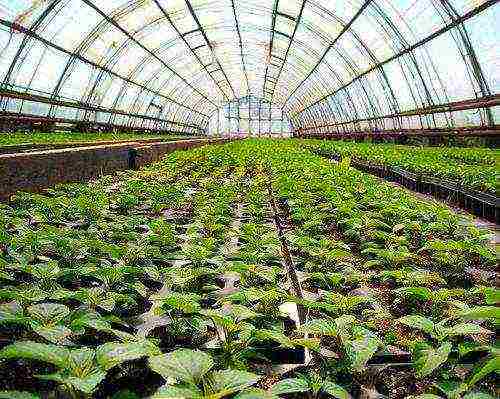
We grow vegetables
Construction of a greenhouse for growing vegetables
Growing vegetables in a greenhouse requires first of all building a reliable structure. It is especially important to build a solid greenhouse for those gardeners who plan to grow vegetables not only for their own table, but also for sale.
To grow vegetables even in severe cold, you will need to build a heated vegetable greenhouse. For the construction of such structures, two types of building materials are most often used - glass or polycarbonate. However, it is difficult to call a greenhouse made of glass a reliable structure, glass is easy to break or otherwise damage. Therefore, modern gardeners prefer to grow vegetables in a polycarbonate greenhouse (photo).
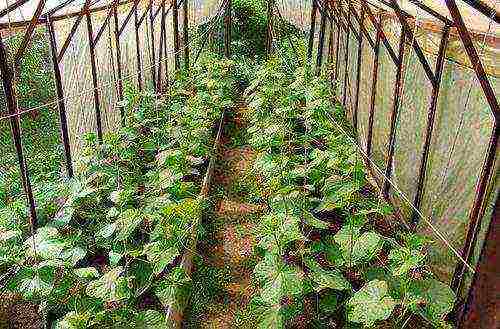
Polycarbonate greenhouses have the following advantages:
- Polycarbonate is a material that retains heat well inside the greenhouse;
- The material is lightweight and therefore you do not have to build a massive and expensive frame for a greenhouse.
- Polycarbonate easily bends, allowing you to build arched greenhouses.
Choose the right place for your greenhouse. The location of the greenhouse should be sunny and protected from the wind. Also, when building a greenhouse for growing vegetables for sale, you need to know about the following: if you are building a large structure and plan to grow vegetables on an almost industrial scale and in the future sell them through legal entities, you will need to draw up the appropriate package of documents. Therefore, draw up a business plan for the vegetable greenhouse in advance, calculate the upcoming costs for both construction and paperwork.
You can watch the stages of construction of a heated polycarbonate greenhouse in the video attachment to the article.
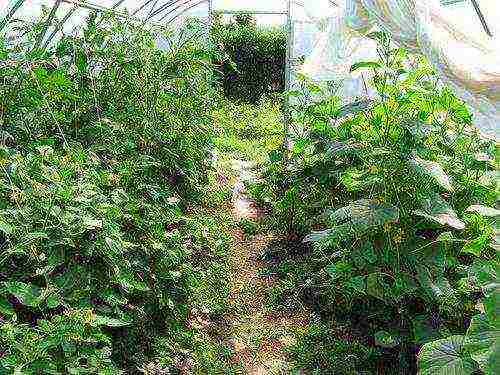
Basic recommendations for the agricultural technology of vegetable crops in the greenhouse
But building a greenhouse for growing vegetables all year round is not enough. You need to know the basic rules of agricultural technology that will help you collect a bountiful harvest of vegetable crops in a greenhouse. Let's take a look at these rules in detail:
- It is necessary to prepare the soil at the greenhouse installation site. The soil is dug up and heated to a certain temperature. Heating is carried out either with the help of special equipment, or by an artisanal method: before planting the seeds, the soil is spilled with boiling water and covered with a film. Two hours after this procedure, you can plant the seed;
- You also need to prepare the seeds in advance. Buy vegetable seeds from reputable specialty stores;
- It is necessary to warm up the greenhouse itself.A comfortable temperature for growing vegetables in a greenhouse is considered to be a temperature of twenty-two degrees Celsius.
You also need to ventilate the greenhouse and make sure that all the equipment installed in the greenhouse is working.
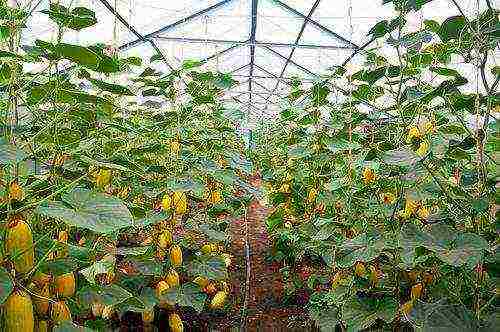
Transplanting
A greenhouse for vegetables will function in full all year round if you approach the issue of planting seedlings correctly. Crops planted in the soil in winter will cease to bear fruit by about the beginning of the spring season, and therefore, if you want to harvest from the beds 365 days a year, the seedlings must be planted using the conveyor method.
For this purpose, a special rack is equipped in the greenhouse (photo), which must be placed as close as possible to the glass, that is, to live sunlight. The seed is sown every 14 days - so you will have seedlings of different ages at your disposal.
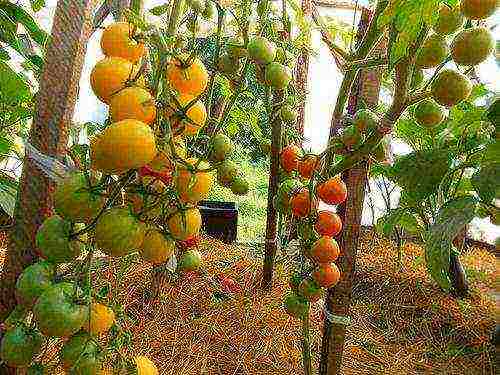
Note: it is impossible to plant the same crops in the same place all the time. After four planting cycles, the crops should be swapped: for example, put in the place in which the cabbage grew, the pepper.
After you harvest the seedlings of the 4th planting (this happens around June), you need to make a special treatment in the greenhouse: ventilate the greenhouse well, fertilize the soil and let the soil rest. The time of the next planting of seedlings before winter is September-November.
We take care of the seedlings correctly
If you are planting seedlings in soil prepared in the fall, you do not need to heal the seedlings with fertilizers, however, when replanting, the soil must be loosened and fertilized.
Keep in mind that in greenhouse conditions, sprouts extremely quickly absorb both moisture and oxygen, and therefore it is necessary to water the seedlings as the soil dries out. If the sprouts do not have enough water, greens will grow, but the ovaries will appear rare.

Tip: If you plan to grow vegetables for yourself and in small quantities, it makes sense to breed and grow seedlings in the house, planting the seed in peat cups and only then planting the sprouts in the ground. This will allow you to reduce your greenhouse lighting and heating costs.
Care of seedlings planted in permanent greenhouse beds
In order to collect a rich harvest of vegetable crops in your own greenhouse, you need to take care of the plants as carefully as when planting seedlings in open ground.
Do not forget to organize the correct irrigation system in the greenhouse, maintain the desired temperature regime, and ventilate the structure from time to time.
For the convenient growth of crops, it is required to erect special structures: for example, so that the cucumbers trudge up, build racks and stretch the threads along which the stems of the plant twist.
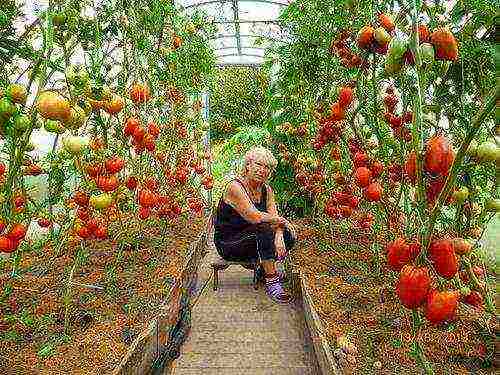
Tomato seedlings and peppers are strengthened with twine and support. This measure is necessary so that the plant does not break from the weight of the fruit. Attention! Never plant bell peppers next to bitter vegetables in the greenhouse. If you plant different varieties of peppers in this way, the fruits of the sweet peppers may turn out to be bitter.
The least capricious vegetable for greenhouse cultivation is cabbage. It can be planted at any time, next to any crops and used for planting seeds of any kind.

